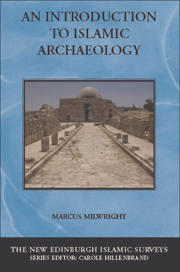Book contents
- Frontmatter
- Contents
- List of figures
- Acknowledgements
- Notes on transliteration and dating
- List of abbreviations
- 1 Introduction
- 2 Early Islam and late antiquity
- 3 New directions in the early Islamic period
- 4 The countryside
- 5 Towns, cities and palaces
- 6 Religious practice in the Islamic world
- 7 Crafts and industry
- 8 Travel and trade
- 9 The ‘post-medieval’ Islamic world
- 10 Conclusion
- Glossary
- Dynasties and periods
- Bibliography
- Index
4 - The countryside
Published online by Cambridge University Press: 05 August 2013
- Frontmatter
- Contents
- List of figures
- Acknowledgements
- Notes on transliteration and dating
- List of abbreviations
- 1 Introduction
- 2 Early Islam and late antiquity
- 3 New directions in the early Islamic period
- 4 The countryside
- 5 Towns, cities and palaces
- 6 Religious practice in the Islamic world
- 7 Crafts and industry
- 8 Travel and trade
- 9 The ‘post-medieval’ Islamic world
- 10 Conclusion
- Glossary
- Dynasties and periods
- Bibliography
- Index
Summary
The study of life in rural areas is an important aspect of Islamic archaeology. Allowing for the importance of trade and industry, the production of agricultural commodities represented the economic foundation of most pre-modern Islamic polities. Clearly this is a vast topic, and a single chapter is insufficient to do justice to the range of environmental and cultural factors that have shaped every aspect of rural life, from demographic patterns and strategies of land exploitation to the internal arrangement of structures within a settlement and to the nature of the material record. Settlements themselves can vary from villages and small market towns to more transient modes of occupation, while some groups may shift on a seasonal basis between sedentary and nomadic lifestyles.
To take just one example, the issue of diversity is well illustrated through the consideration of rural settlements. As discussed in chapter 2, late antique provincial towns such as Umm al-Jimal in northern Jordan (Fig. 2.7) and Shivta in the Negev adopt an ‘organic’ plan, composed of an agglomeration of clusters of buildings that probably reflect familial and clan ties. Irregular arrangements of buildings can also be seen in the vicinities of some Umayyad qusur (chapter 5), while at a smaller level the late antique/early Islamic village of Risha in the east Jordanian steppe is composed of a loose configuration of varied courtyard houses. Numerous excavations have illuminated the evolution of villages in Jordan and Palestine throughout the Islamic period.
- Type
- Chapter
- Information
- An Introduction to Islamic Archaeology , pp. 59 - 74Publisher: Edinburgh University PressPrint publication year: 2010



